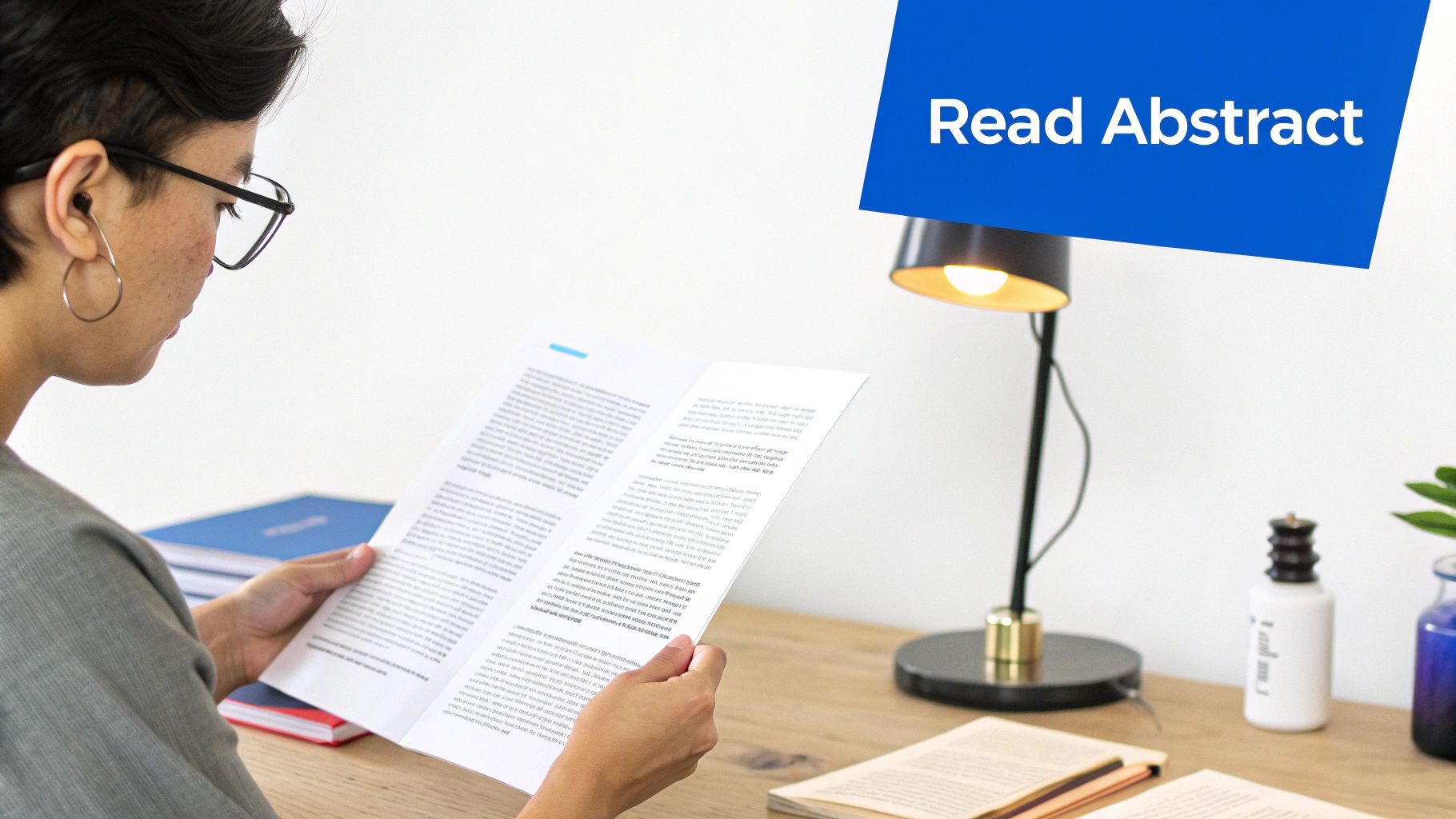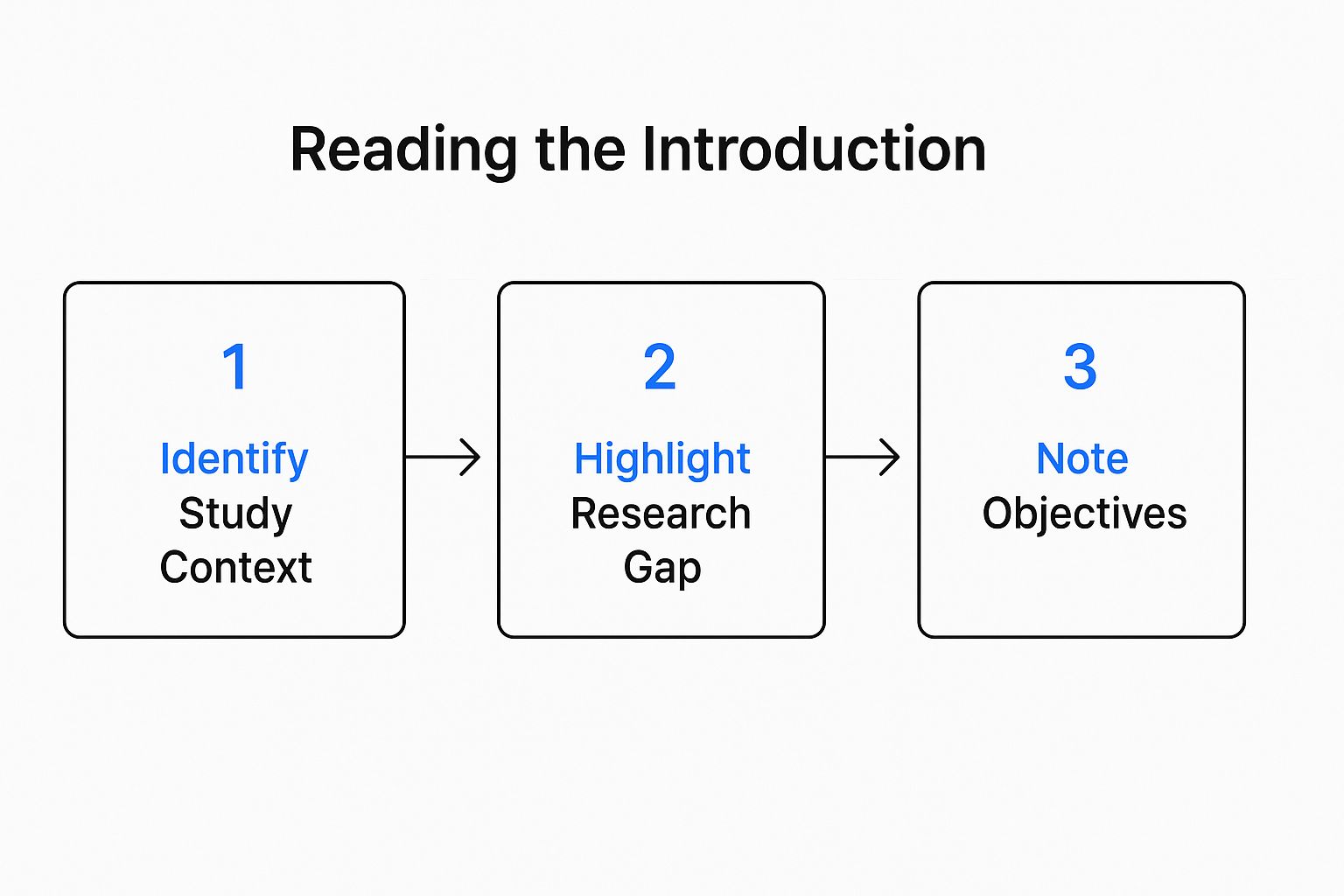Here’s the thing about reading a scientific paper: you don’t read it like a novel. You can’t just start at the beginning and read straight through to the end.
The most effective way is to dissect it strategically. I always start with the abstract, then jump to the figures and the conclusion. This gives me the big picture—the core findings—before I decide whether it’s worth committing to a deep dive into the dense methods and results. Think of it less like reading and more like solving a puzzle.
Why Reading Scientific Papers Is a Learned Skill

If you’ve ever felt completely swamped trying to make sense of academic research, you’re in good company. These papers aren't written to be entertaining; they're dense, highly specialized documents built for a very specific audience. The first step to getting better at this is realizing it’s a skill you develop over time, not something you’re just supposed to know.
And you need an efficient strategy, because the sheer volume of research being published is staggering. In 2022 alone, the world saw about 3.3 million new scientific articles. You simply can't afford to spend hours on a single paper only to find out it's not relevant to your work. A solid reading method is your best defense against information overload. You can see the full scope of this growth in the NSF Science and Engineering Indicators 2023-2024 report.
Your Roadmap: The IMRaD Structure
The secret to navigating these papers is understanding their predictable structure. The vast majority follow a format called IMRaD.
It’s a simple acronym that breaks down like this:
- Introduction: This is the "why." It sets the scene, explains the problem, and states the purpose of the study.
- Methods: This is the "how." It’s a detailed blueprint of the experiments—what materials were used, what procedures were followed.
- Results: This is the "what." It presents the raw, uninterpreted findings, usually with tables, graphs, and figures.
- Discussion: This is the "so what." Here, the authors interpret their findings, discuss limitations, and point toward future research.
Once you understand this structure, you can stop reading linearly and start reading with purpose. For a quick reference, here’s how I think about each section.
The IMRaD Structure: A Quick Reference
This table breaks down the standard structure of a scientific paper to help you navigate each section with a clear purpose.
| Section | What It Is | Key Question to Ask |
|---|---|---|
| Introduction | The background and rationale for the study. | "Why was this research necessary?" |
| Methods | The step-by-step description of how the research was conducted. | "Is this experimental design sound and repeatable?" |
| Results | The objective presentation of the data and findings. | "What did they actually find?" |
| Discussion | The interpretation of the results and their implications. | "What do these findings mean, and why do they matter?" |
This framework is your most reliable tool. Instead of slogging through from page one, you can use IMRaD to hop around strategically. For example, I’ll often read the Introduction and then jump straight to the Discussion. This lets me connect the original question to the authors' conclusions without getting bogged down in the Methods on my first pass.
By seeing the IMRaD structure as your guide, you can jump between sections with a clear purpose, pulling out the information you need without getting lost in the technical jargon.
This is what separates an expert from a novice. You're not just passively reading; you're actively deconstructing an argument, piece by piece, and evaluating the evidence as you go.
Your First Pass: The Strategic Skim
It’s tempting to dive into a scientific paper headfirst, starting at the first sentence and wrestling with every line. But trust me, that’s a quick path to frustration. Before you invest hours into one article, you need to know if it's even worth your time. That's what a strategic skim is for—it's a quick, focused pass to get the lay of the land.
Think of it as reconnaissance. You’re not aiming to absorb every detail just yet. Instead, you're building a mental map of the paper: What was the central question? What did they find? And why does it matter? This initial survey is the key to navigating the vast ocean of academic literature without drowning.
Start with the Bookends: Abstract and Conclusion
The first place I always look is the abstract. It's the author's elevator pitch, packing the entire study—the problem, methods, key results, and conclusion—into roughly 250 words. It’s your best friend for a quick overview.
After that, I skip everything in the middle and jump straight to the conclusion. Sometimes this is its own section, but often it’s the last few paragraphs of the discussion. Reading the abstract and conclusion back-to-back gives you a surprisingly clear snapshot of what the researchers set out to do and what they ultimately found.
Let the Visuals Tell the Story
Once you’ve got the basic narrative down, your eyes should go straight to the figures and tables. I can't stress this enough: the visuals are often the heart of the paper. Don't get bogged down in the specifics—just scan them, reading the captions and legends to orient yourself.
You're looking for the big picture here.
- Do the graphs show any obvious trends?
- Are there significant differences between groups in the tables?
- What is the core evidence they’re trying to show you?
More often than not, you can grasp a study's main findings just by looking at its visuals, long before you ever touch the dense Results section. This visual-first approach builds a solid framework for understanding the paper’s evidence when you decide to read more deeply.
This infographic breaks down a simple flow for tackling the introduction, which is another key part of your initial skim.

Running through this process helps you quickly lock onto the study's context, the specific problem it addresses, and what the authors hoped to achieve.
Check the Foundation and the Conversation
Lastly, give the reference list a quick scan. You’re not reading every citation, just looking for familiar names and patterns. Do you recognize any of the key authors or foundational papers in your field? If the paper is citing work you already know, that’s a strong signal it’s relevant to your interests.
By skimming strategically, you're not just reading faster; you're actively filtering. This allows you to quickly triage papers, dedicating your valuable time and energy only to those that truly matter for your research.
This isn't just a personal trick; it's how experts operate. Research has confirmed that seasoned readers prioritize sections like the abstract, figures, and conclusion to efficiently sift through the enormous volume of literature. You can read the full research on effective reading strategies to see how these approaches work. The skim isn't a shortcut to understanding; it's a smart first step.
The Deep Dive: Reading for Full Comprehension

Alright, the paper passed the initial sniff test. Now it’s time to really dig in. This is where you roll up your sleeves and engage with the text line by line to build a genuine understanding of the research.
The goal isn't just to passively absorb the words but to actively dismantle the authors' arguments, evidence, and conclusions. Forget reading it from start to finish like a novel. A more strategic approach works much better. We're going to tackle this in an order that makes sense for comprehension, not necessarily the order it was written.
This is how you move from just reading a paper to truly analyzing it.
Finding the "Why" in the Introduction
Your first real stop is the Introduction. You glanced at it during your skim, but now you’re reading with a detective’s eye. Your main goal here is to nail down the exact problem the researchers are trying to solve.
Look for those tell-tale phrases that signal a knowledge gap, like "however, it remains unclear..." or "little is known about..." Those are your signposts.
As you read, try to boil down the background information into just a couple of sentences. What’s the context? Then, lock onto the specific research question or hypothesis. This is the absolute foundation of the entire paper, so make sure you’ve got it crystal clear before you go any further.
Tackling the (Sometimes Scary) Methods Section
Next up, the Methods section. Let’s be honest, this is often the most intimidating part of any paper, packed with jargon and dense descriptions of procedures.
But here’s the secret: you don't need to be an expert on every single technique to judge the study's quality. You’re looking for the big picture—the validity of the overall experimental design.
Ask yourself a few key questions as you go:
- Does the approach actually make sense? Does the experiment they designed logically address the question from the introduction?
- Is the sample size reasonable? A study with 200 participants is a lot more compelling than one with just two.
- How did they control the experiment? Look for the controls they used to isolate the specific variable they were testing.
I've always found it helpful to sketch a quick, simple diagram of the experiment. The act of translating the dense text into a visual can suddenly make the whole process click into place, which makes understanding the results way easier.
Making Sense of the Data in the Results
With the methods understood, you’re ready for the Results. Go back to those figures and tables you glanced at earlier. This time, read the text that goes with them. The text here should be a straightforward guide to the data, telling you what the findings are without much interpretation... yet.
Your task is to connect the dots yourself. How does Figure 1 support (or refute) a piece of the main hypothesis? What does a p-value actually mean in this specific context?
The key is to form your own initial interpretation of the data before you read the authors' take on it. This single step is crucial for developing your critical thinking skills. It stops you from just nodding along with their conclusions and forces you to question the evidence for yourself.
Grasping the "So What?" in the Discussion
Finally, you’ve arrived at the Discussion. This is where the authors get to interpret their own findings, explain why they matter, and situate their work within the wider field. Now, compare their conclusions to the ones you came up with when you looked at the results. Do they line up?
Pay close attention to any limitations they mention. No study is perfect, and good researchers will be upfront about the weaknesses in their work. This section is also where you'll often find a goldmine of ideas for future research, which can be incredibly useful for sparking your own projects.
Keeping all these papers, notes, and interconnected ideas straight can get messy fast. This is exactly why it's worth learning about the importance of a reference manager to keep your research organized and accessible.
Mastering Active Reading and Annotation
You can't just passively read a scientific paper and expect to remember anything. If you just let your eyes skim the words, the key details will vanish the moment you close the file. To really get anything out of a study, you have to actively engage with it—turn it into a conversation between you and the author.
This goes way beyond just dragging a highlighter across a few sentences. Real annotation is about questioning the authors' assumptions, jotting down your own summaries in the margins, and linking what you’re reading to other papers. You’re essentially building your own layer of analysis right on top of the original work, which is the only way to truly understand and retain the information.
Develop a Systematic Annotation Method
Randomly highlighting and scribbling notes is a recipe for chaos. Trust me, you need a system. I’ve found that a simple color-coding scheme works wonders, whether I'm working with a stack of printed papers and physical highlighters or using digital tools.
When you have a consistent system, you can quickly scan a paper months later and immediately find what you're looking for. It saves an incredible amount of time.
Here's a simple color-coding system I've used as a starting point. Feel free to adapt it to what makes sense for your field and your brain.
Effective Annotation Color-Coding System
| Color | Purpose | Example |
|---|---|---|
| Yellow | Key findings & main arguments | The sentence that spells out the study's main conclusion. |
| Green | Novel methods or techniques | The part where they describe a new experimental setup or a unique statistical approach. |
| Blue | Important definitions & background info | A definition of a key term you might need to reference later. |
| Pink/Red | Questions, surprising results, or limitations | An unexpected finding that contradicts the hypothesis, or a weakness the authors admit to. |
A structured approach like this turns your highlights from a random mess of color into a meaningful, organized map of the paper's most important parts.
Go Beyond Highlighting with Marginal Notes
Highlighting points you to the important text, but your marginal notes are where the real thinking happens. This is your space to challenge, question, and connect with the author's ideas. Make your notes active and inquisitive.
- Ask questions. Don't be afraid to write things like, "Why this assumption?" or "Is this sample size really big enough?" in the margins.
- Summarize paragraphs in your own words. Force yourself to process the information by writing a quick one-sentence summary next to a particularly dense paragraph.
- Make connections to other work. Jot down notes like, "Reminds me of Smith (2021)'s counterargument," to build a web of knowledge.
By actively questioning and summarizing as you read, you're not just consuming information; you're building your own understanding of the research. You're turning a monologue into a dialogue, and that’s what makes the information stick.
This active engagement is so much more effective than just reading. Many of us now use digital tools to keep all these notes organized. If you're looking for a good platform, check out our guide on the best reference managers for annotations and note-taking. These tools let you keep your papers, highlights, and notes all in one searchable place, helping you build a powerful personal knowledge base over time.
Putting It All Together: From Reading to Real Understanding

Getting through a paper is one thing, but the real work starts after you've finished the last sentence. This is where you shift from just absorbing information to actively questioning it. It's the moment you stop being a passive reader and become a critical thinker.
After a deep dive, your notes might feel a bit scattered. The first thing I always do is try to synthesize. Can I explain the entire paper—its central question, key findings, and final take—in just a few sentences? If I struggle, that's my cue to go back and reread a specific section until it clicks.
Becoming a Healthy Skeptic
Once you can summarize the paper with confidence, it's time to put on your skeptic's hat. Good science is built on scrutiny, so your job is to really test the paper's arguments and the evidence backing them up. Over the years, I've developed a sort of mental checklist I run through with every paper to gauge its real strength.
Here are the big questions you should be asking:
- Do the results actually back up the conclusions? This is the single most important check. I'm always on the lookout for any major jumps in logic between what the raw data shows and the story the authors tell in the Discussion section.
- Did the authors acknowledge their study's limitations? Every study has weaknesses. Honest, reputable researchers are up-front about them. If they gloss over limitations or pretend there are none, that’s a huge red flag.
- Are there other possible explanations for the findings? Think like a detective. Could something else explain the results? Did the researchers properly account for other variables that might have skewed their data?
- Is this work genuinely new? You need to understand how this research fits in. Does it build on what we already know, or does it challenge long-held assumptions? A quick scan of the literature review in the Introduction usually gives you the context you need.
This process isn't easy. Scientific papers are dense and full of specialized language. You have to know the jargon and understand the standard IMRaD format. It’s a very different skill from casual reading. While plenty of people enjoy books—with 27% of readers finishing over 20 in a year—scientific articles demand a much more rigorous level of engagement. You can explore some global reading habits to see just how different these two types of reading are.
Seeing the Bigger Picture
No single paper is ever the final answer. Think of it as one data point in a vast, ongoing scientific conversation. To really understand its importance, you have to connect it to the research that came before and the work that will follow.
To truly gauge a paper's impact, you must look beyond its four corners. A paper’s value is defined not just by what it says, but by how it influences the ongoing conversation in its field.
I always look at the citation chain in two directions. First, check the references to see whose shoulders the authors were standing on. Then—and this is key—use a tool like Google Scholar or your library's database to see who has cited this paper since it was published. This is the best way to see how the scientific community has reacted to the work and built upon it.
This is where the real insights happen. Of course, keeping all these connections straight across dozens of papers can feel overwhelming. Luckily, there are great systems for that. If you're looking for ways to manage all this information, you might find our guide on modern approaches to research organization helpful.
Stumbling Blocks You'll Hit (And How to Get Past Them)
Even with the best strategy in hand, tackling academic papers can feel like learning a new language. You're not alone. Most of us run into the same walls when we're starting out. Let's talk through a few of the most common hurdles you're likely to face.
How Long Is This Supposed to Take?
I get this question all the time. The honest answer? It depends. There's no magic number.
A quick first pass just to see if a paper is even relevant might only take you 10-15 minutes. But for a paper that’s central to your work, a deep, note-taking, truly-understand-it read? That could easily stretch into a few hours.
If it feels painfully slow at first, breathe. That’s completely normal. You're building a new skill. With every paper you read, you get a little better at spotting the key arguments and navigating the jargon of your field. Speed comes with practice, not from watching the clock.
What If I Don’t Get the Methods or Statistics?
This is probably the single biggest source of anxiety for newcomers. It’s easy to feel like an imposter when you hit a wall of complex statistical tests or lab procedures you've never heard of.
Here’s the secret: you don't have to be an expert in every technique to get the gist of the paper.
Your first goal is to understand the overall approach. What were they trying to do? If a specific method seems absolutely critical to their main finding, that's your cue to do a quick Google search. You're just looking for a basic "what is this and why would you use it" explanation, not a PhD-level understanding.
When it comes to the stats, focus on how the authors talk about them in the Results and Discussion. Your job is to understand what a result (like a p-value) means for their argument, not to run the numbers yourself.
My Two Cents: Don't let one confusing paragraph about a statistical model stop you in your tracks. Note it down, and keep moving. More often than not, you can understand the paper's main takeaway without it. If it turns out to be crucial, you can always circle back.
Is It Cheating to Read the Sections Out of Order?
Not only is it okay, it's what the pros do. Seriously, I can't remember the last time I read a paper straight through from page one. Reading out of order isn't a shortcut; it's a smart strategy.
Try this "outside-in" approach. It works wonders:
- Abstract: Start here for the 30,000-foot view.
- Introduction & Discussion/Conclusion: This gives you the story of the paper—the "why" and the "so what."
- Figures & Tables: Now, look at the evidence yourself. What story does the data tell you before you read their full explanation?
- Methods & Results: Finally, dig into the nitty-gritty to see exactly how they did it.
This method arms you with context before you dive into the dense, technical details. It makes the entire paper far less intimidating and much easier to piece together.
Tired of juggling a dozen open PDFs and notes scattered everywhere? Eagle Cite is a modern reference manager built to help you organize your research and find what you need in seconds. Spend less time managing and more time understanding. Start your free 14-day trial of Eagle Cite and feel the difference.